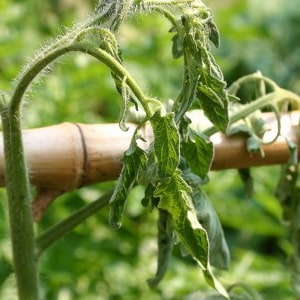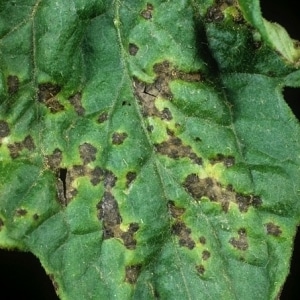What is tomato bacteriosis, why does it appear in a greenhouse, and how to quickly and effectively cure it
Novice gardeners may naively believe that a greenhouse will protect tomatoes from disease. However, in reality it turns out that artificially maintained temperature and humidity levels are favorable for the causative agents of many diseases. What to do if plants begin to wither for no apparent reason? This could be tomato bacteriosis. What kind of disease is it, can it be cured and how to protect the crop from destruction - you will learn all this from our article.
Tomato bacteriosis - what kind of disease is it?
Bacteriosis is a dangerous disease that develops unnoticed, but because of it the entire crop can die. The disease is of the bacterial type and can affect the roots and vascular system of the plant. The causative agent is multinuclear bacteria from the families Mycobacteriaceae, Pseudomonadaceae, Bacteriaceae.
Bacteriosis includes wet rot, root cancer, black leaf spot and general wilting of the plant. The occurrence and development of the disease depends on the number of bacteria entering the plant, the stability of the crop and environmental conditions.
How does it affect tomatoes?
The infection acts from the inside: mucus begins to form in the stem. This occurs due to bacteria blocking the plant's vascular system. The tomatoes are wilting. And not just tomatoes. Types of bacteriosis such as wet rot and black spot affect indoor plants, but increasingly cucumbers, grapes, beans, wheat and other crops have begun to suffer from them.
Symptoms and external signs
The disease develops very slowly, which is why gardeners recognize it already in the last stages, when it is impossible to correct the situation. The latent form can last up to two months: there are no symptoms, but blockage of blood vessels and rotting are already beginning inside the stem. As soon as hot and humid weather sets in, the course of the disease becomes rapid and the plant dies within a few days.
Bacterial wilt
 The disease can occur in two forms: acute and chronic. The first form occurs instantly - the plant dies in three days.
The disease can occur in two forms: acute and chronic. The first form occurs instantly - the plant dies in three days.
The second form lasts no more than a week, and not only the stem, but also the fruits of the plant are affected. Photos of diseased plants show yellowed and curled leaves.
Symptoms of bacteriosis:
- the appearance of brown stripes on the stems;
- formation of “aerial roots” on the root part;
- yellowness of leaves at the bottom of the stem;
- delay in plant development - fruiting shoots stop growing;
- When the stem is cut, mucilage is released.
Black spot
The disease develops in hot weather; when the temperature drops, the pathogen does not die. At the initial stage, shapeless brown dots and spots appear on the leaves, then the formations begin to enlarge and turn black - tissue necrosis occurs.
The death of the plant begins with the falling of leaves, then it turns black and curls. Fruits also suffer from the disease: spots may appear on tomatoes, which later develop into ulcers.
Reasons for appearance and spread
The causative agent of bacterial wilt is the bacterium Erwinia phytophthora, which lives in the upper layers of the soil. The microorganism affects not only nightshades, but also other vegetable crops.Bacteriosis spreads through the root system of the plant.
A favorable factor for the life of bacteria is damp, hot weather with sharp temperature changes during the day and night.
Terms of distribution
Bacteriosis develops rapidly if the air temperature in a greenhouse or hotbed is +19...+24C and there is droplet-liquid moisture present. In addition, the spread of the pathogen is facilitated by high soil pH levels, lack of phosphorus and potassium, as well as the presence of moisture on plant leaves. Excessive use of nitrogen fertilizers also reduces the resistance of tomatoes to the pathogen.
Methods of transmission of bacteriosis:
- damage to the plant stem during weeding, replanting or loosening;
- with insects and rodents that carry bacteria from sick to healthy tomatoes;
- watering with water containing an infectious agent;
- working with untreated garden tools.
Fighting the disease
Control agents can be divided into chemical, agrotechnical and folk remedies.
Chemicals
It is impossible to cure tomato bacteriosis, but if no measures are taken, wilting can spread to healthy seedlings. The affected plant is uprooted and burned.
The remaining seedlings are treated with “Fitolavin” - 20 ml of the substance is dissolved in 10 liters of water. The solution is divided into two parts: one is used for spraying on the leaves of plants, the second is for watering at the root - 30 ml of solution is used per bush.
After the infected plants are burned, it is necessary to disinfect the soil. For these purposes, you can use the drug “Baikal-EM” - dissolve 125 ml of the substance in a bucket of water. 1 sq.m will require 2.5 liters of solution.
Important! Do not treat the soil with chemicals while any plants are growing on it.
For spraying, treating leaves and watering, you can also use the preparations “Phytoplasmin”, “Azofos 65%”, “Virkon S”, “Farmayod”.
Traditional methods
If it is not possible to purchase special preparations for treating plants and soil, you can use a 1% manganese solution - 10 g of potassium permanganate is dissolved in 1 liter of water. The solution is watered onto the soil on which the infected plants grew.
You can slow down the spread of the disease with the help of “Streptomycin” - dilute 2 bottles of the drug in 10 liters of water, add 15 g of quicklime blue stone. Treat sick and healthy plants, repeat the procedure after 3 days.
Agrotechnical techniques
You can avoid the development of tomato diseases if you observe crop rotation on the site. Tomatoes cannot be planted in the same place year after year; it is necessary to take a break between plantings of 3-4 years.
Read also:
Why gray rot appears on cucumbers and how to deal with it.
How to deal with blossom end rot of tomatoes in a greenhouse.
What to do if tomatoes turn black on the bottom and how to prevent the problem.
Prevention
Bacteriosis is easier to prevent than to try to cure.
Prevention of bacteriosis consists of observing the following rules:
- disinfect soil and seeds before planting;

- when purchasing, pay attention to the resistance of the variety to bacterial wilt;
- keep the beds clean so as not to attract rodents and insects that carry bacteria;
- regularly disinfect garden equipment;
- observe crop rotation on the site;
- After harvesting, remove the top layer of soil and treat the area with fungicides.
Advice from gardeners
Experienced gardeners know that you can protect tomatoes from many diseases if you disinfect the seed material before planting. To do this, you can use the drug “Fitolavin” - dissolve 2 ml of the substance in 100 ml of water, soak the seeds in the solution for one hour.
It is also important to disinfect garden tools with Ecocid-S - 50 g of the substance is dissolved in 5 liters of warm water. Spray rakes and diggers.
At the first signs of illness, you can try to pinch the growing point. This method will not cure the plant, but it can delay its death.
If bacteriosis begins to affect tomatoes, then it is necessary to pull out not only the diseased plants, but also 10 healthy bushes that are in the same row with them.
Conclusion
Tomato bacteriosis is a dangerous disease that can cause you to lose your entire crop. Bacterial diseases can be avoided if you treat the seed material and soil before planting, do not forget about regular disinfection of garden tools and observe crop rotation.
If these preventive measures do not help, you can try to save the crop by spraying and watering under the roots with special preparations. In most cases, it is useless to treat the disease; it is much more effective to prevent its development.